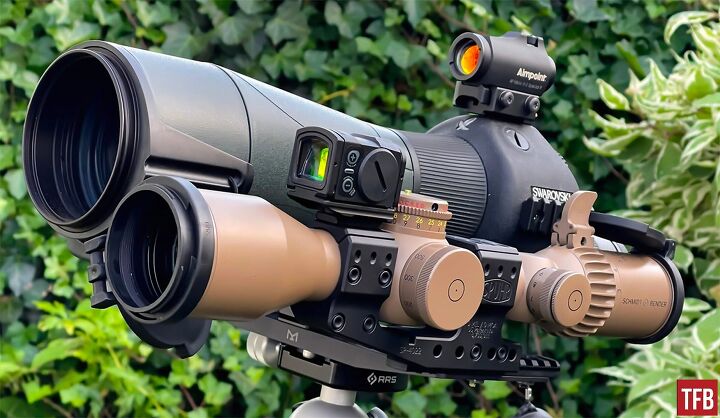The new Aimpoint Acro P-2 was announced in May of this year and shortly after TFB received a sample to review. It’s been two and a half years since we reviewed their Acro P-1, so we looked forward to examining what was new and improved with this model.
Aimpoint @ TFB:
- NEW AIMPOINT – ACRO C2 And P2 – The Next Generation of Red Dot Sights
- TFB Review: Schmidt & Bender 3-27×56 PMII High Power Riflescope + Aimpoint ACRO C-1
- POTD: B&T APC9 Pro with Aimpoint ACRO
- Review: The new Aimpoint ACRO P-1 with Spuhr Interface

The new Aimpoint Acro P-2 on a Glock 45 MOS. Probably one of the best duty pistol and red dot setups available at this point in time.
To begin with the basics: Acro stands for “Advanced Compact Reflex Optic”. Its operating principle is a reflex collimator red dot sight, closed emitter system, with a 3.5 MOA dot size (650 nm red light). It is Night Vision Device (NVD) compatible and submersible to 35 meters (115 ft), quite a lot more than most military units would ever ask for. The “clear aperture” of the P-2 is 15×15 mm (0.59 × 0.59 in) and the aluminum housing has hardened front and rear glass lenses to protect the front lens and LED.
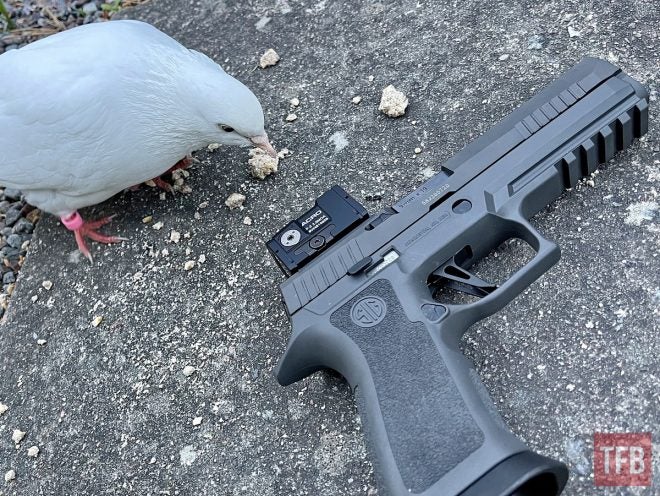
Bird of Peace?
Below: In lack of a submarine to dive out from, we did not test if the P-2 is submersible down to 35 meters or not. But we did our best as it rained almost every day in August so the P-2 got its share of unpressurized water.
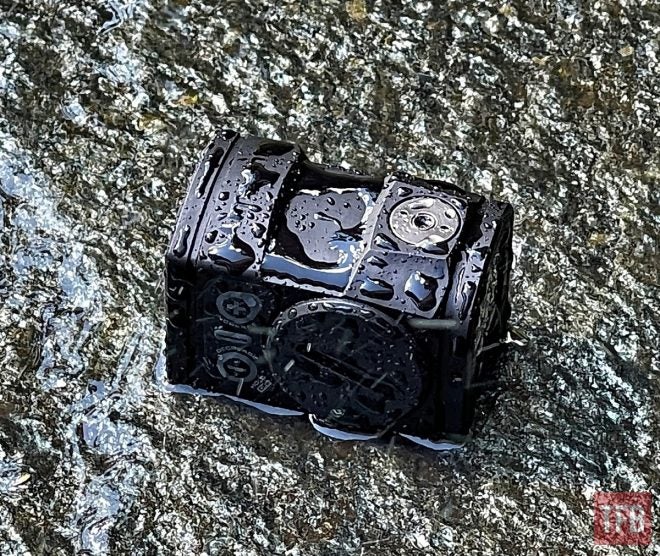
Battery and Battery Life
One thing is for sure, we won’t be able to give you an honest conclusion about what is probably the most awaited upgrade of the Acro – the battery life. The new Acro P-2 includes a brighter, more efficient LED emitter coupled to a higher capacity CR2032 battery. Aimpoint claims that the new P-2 provides over 5 years of constant-on use, which is a bit longer than we run our reviews.
Below: My next gun is going to be a Glock 45 MOS. (Molon Labe – Ultratech knife from Microtech)

That’s 50,000 hours on setting 6/10. I own about 10 Aimpoints and my perception is that Aimpoint’s datasheets, including battery life, can be trusted. There are no automatic ambient light adjustments, no solar panels or radioactive materials to provide extended performance and there is no automatic shut-off. The Acro P-2 is designed to be left with the power on, which I like. Just set a reminder every 4:th year, or every leap year, and you should have plenty of safety.

The battery is sealed within the optic. It is possible to change the battery without removing the sight from the firearm, through a sealed access port on the left side of the aluminum frame (7075-T6). If you ever had an optic that requires you to remove it from the firearm to change the battery, you know why you’d prefer Aimpoint’s design.
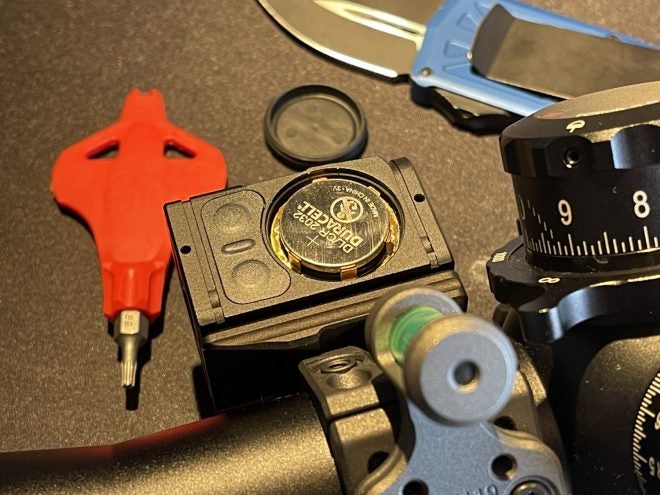
Below: Mounted together with Kahles’ latest K525i DLR riflescope.

The reason why Aimpoint chose the CR2032 battery is because it can be found almost anywhere in the World. For reference, the Acro P-1 utilizes a CR1225 battery with a claimed 2-year run time.
Below: Optional flip-up lenses. I only had a quick look at these and they were pre-production, so they don’t really fall under the review.
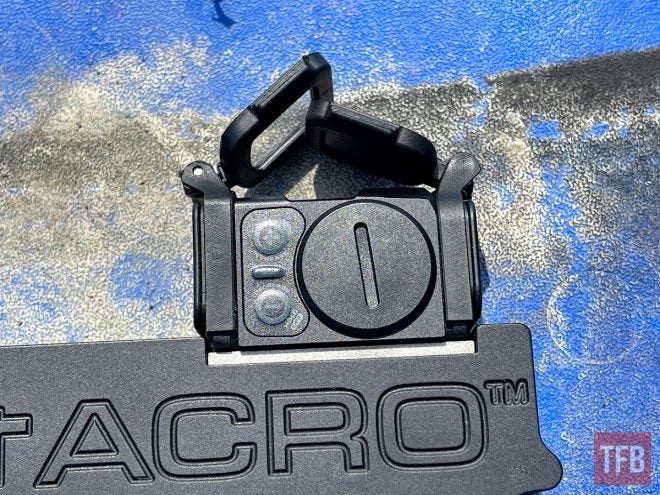
Ergonomics
There isn’t much to feel or touch on a daily basis, apart from adjusting the LED brightness depending on your environment. The brightness keypad has a new design with an excellent tactile feel, and the only concern I have is how the material will withstand prolonged and hard-duty use? Time will tell and I may be wrong. The adjustments for windage and elevation give audible clicks as you turn them, just the kind of feedback you want and I wish other makers would provide in their products. It makes you think about high-end riflescopes Made in Germany. There are no protruding parts in the design, so I would say that the risk of any unintentional changes to the settings is minimal. The P-2’s drop-test survival capabilities should be high. The design and surface finishing blend in on any firearm.
Optical Performance
Looking through the Acro P-2, there is no magnification and I don’t have any complaints about the optical performance. It is my opinion (and my wife said I was right for once) that you get a light blue/grey tint that enhances green colors and reduces yellow, but the effect is almost negligible. It’s not until I sat down and really analyzed that I thought about it.
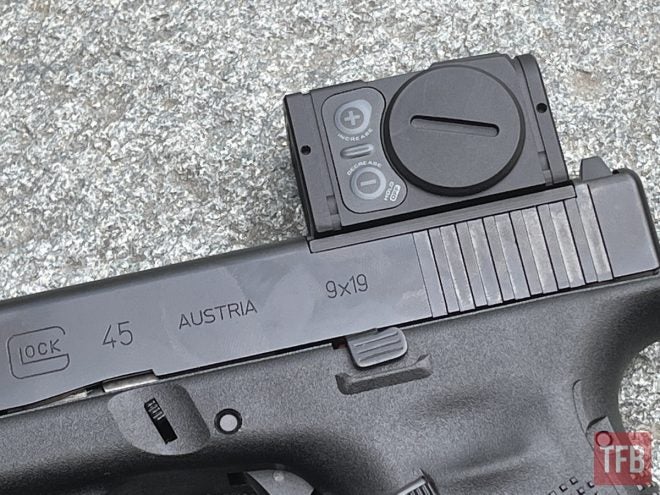
Life on the slide of a semi-automatic pistol
Life on the slide of a semi-automatic pistol is probably as aggressive as it gets for any optic. The Acro is built to endure these extreme physical demands. I’m happy my hands and wrists didn’t do the testing when Aimpoint shot 20,000 rounds of .40 S&W ammunition to verify the design. According to Aimpoint, the .40 S&W caliber generates 7,400 Gs of force, nearly double the level of a normal 9mm caliber pistol.
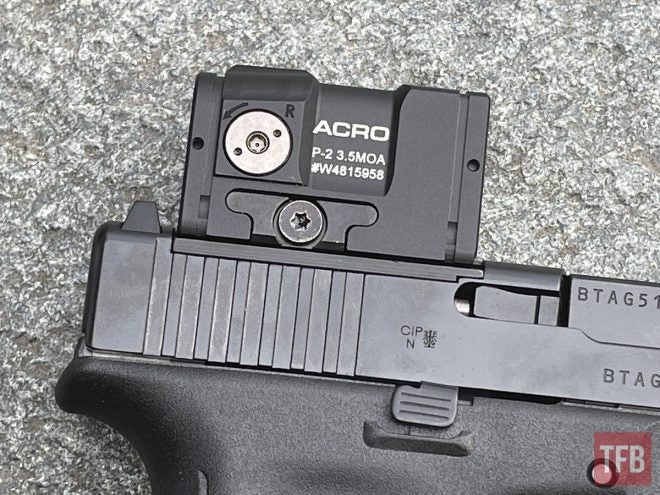
We did not try it, but we have no doubts it would work over and over. The aluminum housing of the P-2 is designed to be able to withstand if you have to manipulate your slide against any hard object in case of an emergency.
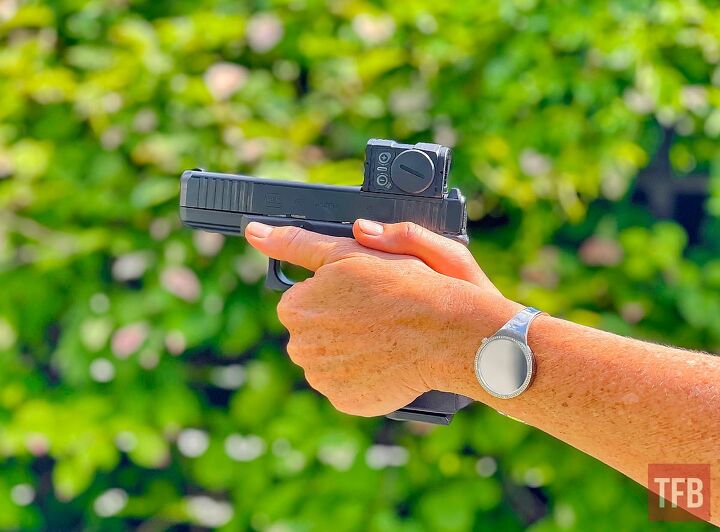
Installing the Acro on a handgun
The Acro P-2 has the same footprint and interface as the Acro P-1, so there is already a huge market from a wide range of suppliers. Typically, the sight interfaces with a dovetail adapter plate that is screwed onto a cut slide. On top of this interface, you place your P-2. There are also Picatinny adapters for rifles etc. In terms of holsters, it should be a similar story, the design is the same as the existing Acros.

Below: It was extremely easy to attach the P-2 to the Glock 45 MOS. Just make sure you apply some Loctite or similar compound onto the screws.

Below: I’m not too familiar with SIGs, but I finally managed to mount the P-2 onto one, learning quite a lot along the way. Beware which interface you chose, as there are plenty out there for the different SIG models. Ask a dealer or Aimpoint for advice.
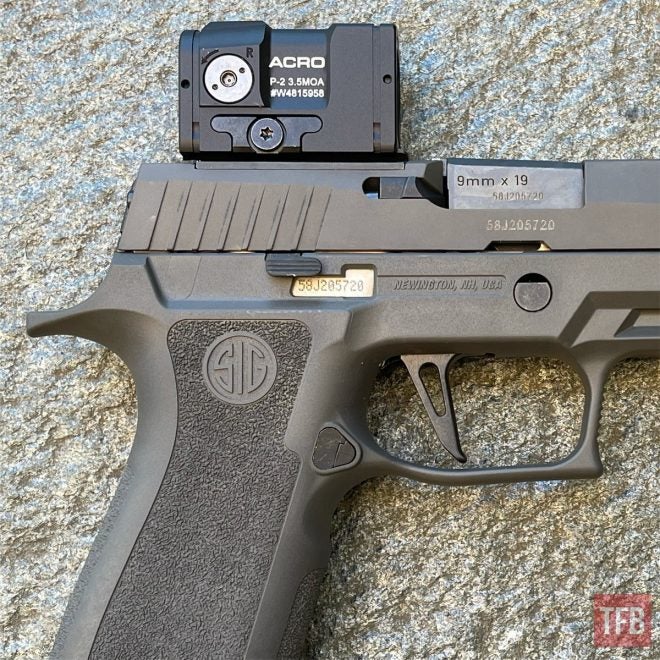
Aimpoint Acro P-2 outside the World of handguns
My personal choice would be to use the Acro P-2 as a secondary aiming device on a long-range rifle, at the 12 o’clock position. I can then run my main optic at high magnification and do the target shifting through the Aimpoint Acro. The Aimpoint Micro works well for this as well, except it is a little larger in a place you don’t want large objects.
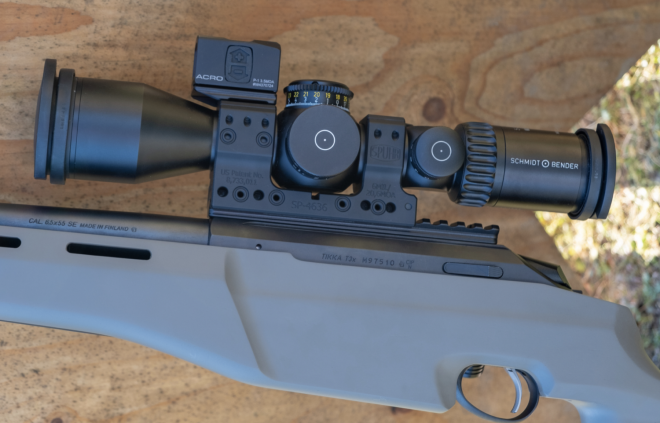
Photo: Spuhr
The Acro P-2 would also work well on almost any shotgun, carbine, PDW or as a backup sight. If I used thermals for long-range, I’m pretty sure I’d find a way to put an Acro on there as well.

Picture: Aimpoint
Technical Specifications – Aimpoint Acro P-2
- Item No. 200691
- 3.5 MOA Red Dot
- Night Vision Compatible (on settings 1-4)
- Brightness Settings, 4 NVG and 6 Daylight
- Battery type: 3V Lithium battery, CR2032
- Battery life: Over 5 years (50,000 hours) of continuous use at position 6/10
- Power on setting: 7/10
- 7075-T6 High-strength Aluminum Hard-anodized
- 9” x 1.3” x 1.2” (L x W x H)
- Submersible up to 35 m / 115 feet
- Temperature range -50° to +160° F
- 60 g / 2.1 ounces (with battery)
- Accessories available: flip-up lens covers, ARD integrated flip-up lens covers, adapter plates, and mounts
- Package includes: CR2032 battery, Aimpoint T10 Tool
Aimpoint brought this clever invention to a competition so that shooters could give it a try. Note the optional flip-up covers, not to mention the beautiful nails. I know a lot of hunters who have been asking for this kind of cover (think snow and heavy rain through forests and fields).
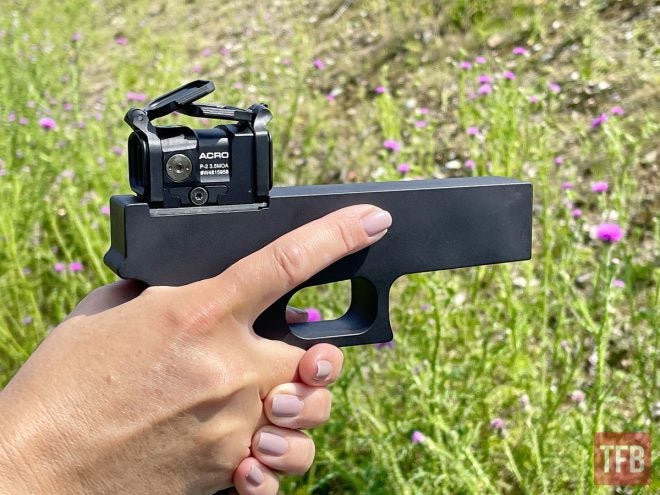
Here you can download and print the Zeroing Target for the Aimpoint Acro Series in your preferred format.
The interface used with the Spuhr mounts in this article is:
Spuhr A-0055 ACRO P-1 Interface. Article no.: A-0055 Price: 45 EUR+.
Interface for attaching the Aimpoint ACRO P-1 & 2 red dot sight to the Spuhr ISMS scope mount. Includes screws. Weight: 20 g/0.7 oz
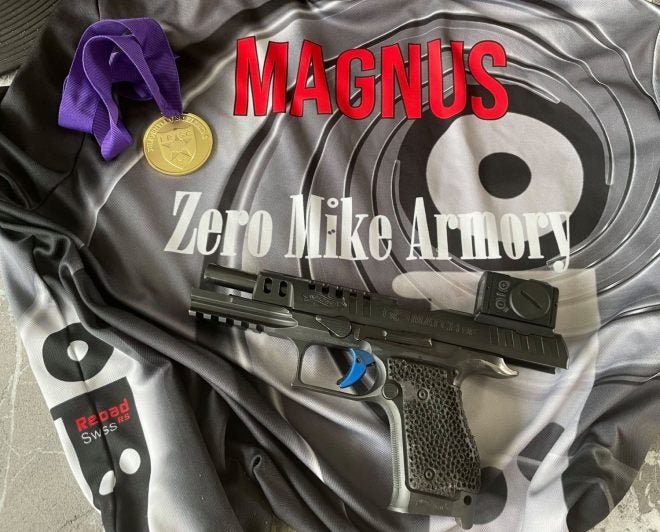
It’s worth mentioning that just before the World closed due to the Covid outbreak last year, I visited the Aimpoint factory and R&D in Malmoe, Sweden. The facility just had a major refurbishment and looked spotless. I was not allowed to take any photographs but it’s safe to say that Aimpoint takes high-end manufacturing and quality control very seriously. At the time I had no idea the new Acro was around the corner.
Price: According to the Aimpoint U.S. website the price is $599.00 for the ACRO P-2 Red Dot Reflex Sight (Item# 200691). For some reason, most quality red dots on the market seem overpriced to me, yet they are often unavailable due to high demand. I guess the market must be right? While the P-2 is not cheap, there are not that many competitors that will offer the same total package. The warranty & service terms can be found here.
Below: The riflescope below is the exact same as the Canadian Army bought for their C20 DMRs, which TFB has for review. It’s the Schmidt & Bender 3-20×50 Ultra Short in custom Coyote M17 Tan. Here with the Aimpoint Acro P-2 in a Spuhr cantilever mount. Excellent products in great co-operation.
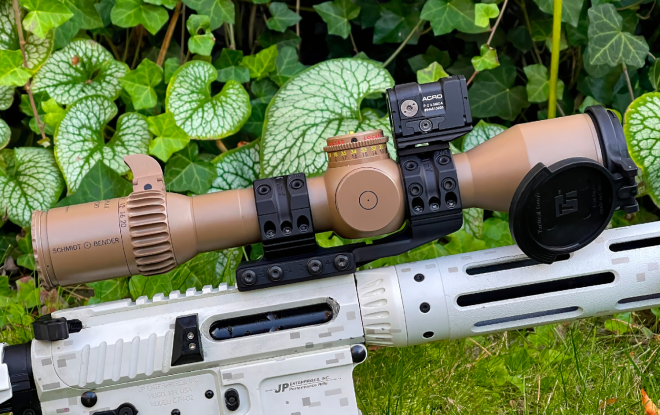
Availability: If you bought my review (so far) and want your own P-2 you might run into some problems. Several Government agencies may already be a step ahead of you, and with priority. As the production is being ramped up there might be only very limited supplies of the P-2 for the civilian market.
Conclusion
The perfect red dot still doesn’t exist in my opinion, but every year the manufacturers are getting closer and closer. The main difference between the Aimpoint Acro P-1 and P-2 is a complete redesign to fit the larger battery. The Acros look similar, but as I started to study them side by side on a detailed level, I noticed that I couldn’t really see any similarities at all. Below is my custom painted C-1 vs. the P-2 (right) that Aimpoint supplied for this review.
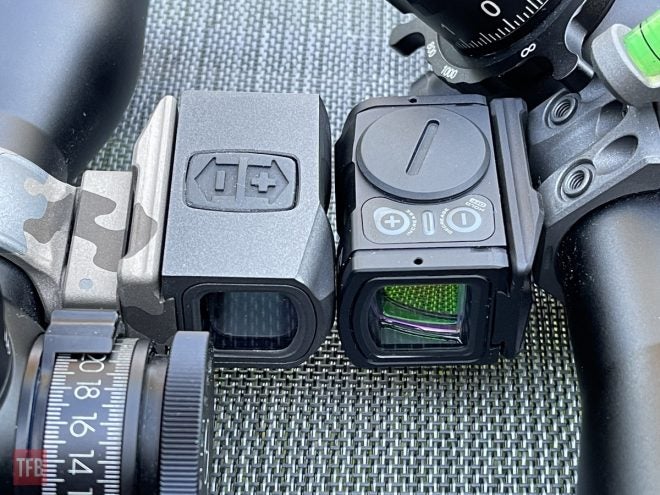
Interestingly, Aimpoint managed to keep the same size and weight. It is said that the new LED technology gives the P-2 an even brighter 3.5 MOA red dot, but I cannot say that I could spot the difference. On a sunny day, they both deliver enough light for the dot. The footprint is more or less similar to any other pistol sights, however, the Acro is about 0.1” taller than the others. This increased “margin” has gone into making the P-2 sealed and water/shock-proof.

To me, shooting the Acro sight on a pistol in a competition is a little more difficult compared to an open design with a large window but I also have much more experience with the latter. Since the P-2’s aperture window is a bit smaller than the “go-fast” red dots I would prefer an open design with ultra-thin wall sections that lasted forever. Unfortunately, life on the slide of a pistol is about as harsh as it gets, so it’s a bit of a contradiction. You can’t get both! It wouldn’t be the first time in history where different needs require different tools.
Due to the P-2s closed design with more material in the frame around the lens, I find it a little bit more difficult to find the dot versus other open designs when I’m shooting from a new or awkward position. I do understand that is mainly due to lack of training, and perhaps my “shooting with both eyes open” isn’t as present in my subconsciousness as I’d like to think.
Below: SIG Sauer P320 X-Five and Aimpoint Acro P-2.

Here is an excellent example between a Shield sight vs. the Aimpoint Acro P-2 mounted on a Glock 17 and a Glock 45. I would not choose the Shield sight for my duty gun (if I had one), but I could use the P-2 on both my competition gun and my duty gun and perform really well, or even win. If I was allowed a gun for self-defense it would be the gun below to the right I’d have by my bedroom table.
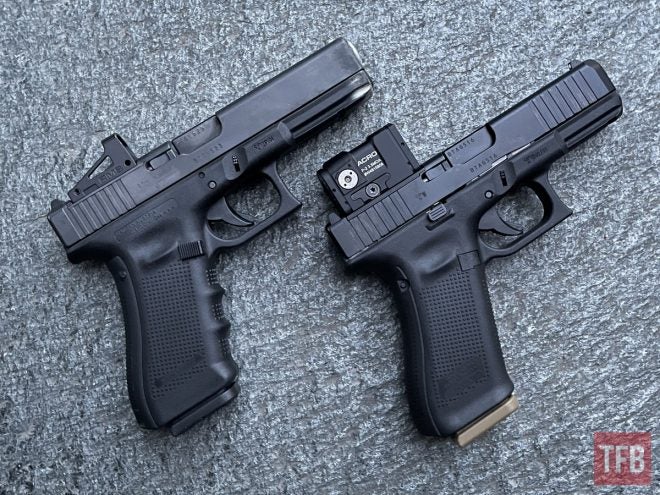
To me personally, the Acro P-2 is mainly going to be used as a secondary sight on a rifle. However this is not what the P-2 was primarily designed to do, but I don’t run around and pretend I’m anything but a recreational sports shooter. I don’t dive armed to the teeth out of a submarine either, but if I did, it would be with the P-2 on the gun.

Photo: Aimpoint
The market for the P-2 is of course much larger than for a few combat divers. If I was running into harm’s way and needed a red dot on the slide of my duty gun the P-2 would also be my first choice.
The website of Aimpoint USA can be found here: https://aimpoint.us/

We are committed to finding, researching, and recommending the best products. We earn commissions from purchases you make using the retail links in our product reviews. Learn more about how this works.
 Your Privacy Choices
Your Privacy Choices
